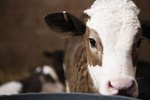The entire bovine labor and delivery process is usually over in less than eight hours. Most cows go into labor and give birth without a problem. Still, it's important to be there for the birth just in case this time is an exception, and your cow experiences birthing difficulties or the calf has issues. If your cow is due to give birth, check her at least three times daily, looking for physical and behavioral changes. If she's a heifer and this is her first pregnancy, check her more often.
Physical Signs
As the cow gets ready to calve, physical changes give you a clue that labor and delivery are imminent. Watch for:
- Udder filling -- generally within two weeks of birth.
- Pelvic ligament relaxation -- the ligaments between the tail head and the buttock point start sinking within 12 to 24 hours of birth, but it is hard to observe in overweight cows.
- Teat strutting -- the teats begin pointing outward rather than hanging down.
- Relaxation of the vulva.
Behavioral Changes
As labor starts, the cow will likely isolate herself from the rest of the herd. She becomes restless, and has little or no interest in food. As labor progresses, she may get up and down, and lift her tail.
It's far more common for a heifer to appear in pain and look uncomfortable than a cow who has had several calves -- the experienced ones know what is coming and tend to take it more in stride. The initial stage of labor lasts between two and six hours. The cow begins straining and arching her back.
Warnings
If your cow's labor hasn't progressed within eight hours, call your veterinarian.
Temperature Checking
The cow's temperature may indicate when labor starts. Ask your veterinarian about obtaining a temperature sensor bolus, which is placed in the reticulum, or first of her stomach chambers. A receiver can pick up the temperature data. Generally, a cow's temperature drops about 12 to 24 hours before giving birth.
Writer Bio
Jane Meggitt has been a writer for more than 20 years. In addition to reporting for a major newspaper chain, she has been published in "Horse News," "Suburban Classic," "Hoof Beats," "Equine Journal" and other publications. She has a Bachelor of Arts in English from New York University and an Associate of Arts from the American Academy of Dramatics Arts, New York City.





